Financial Analysis: Capital Budgeting Decision for KKP Ltd. Project
VerifiedAdded on 2023/06/08
|13
|1840
|487
Report
AI Summary
This report provides a financial analysis of KKP Ltd's potential investment in proximity sensors for the food industry, utilizing capital budgeting techniques such as Net Present Value (NPV), Internal Rate of Return (IRR), and payback period. The analysis considers initial cash outflows, depreciation, revenue, variable costs, fixed costs, and salvage value to determine the project's feasibility. Quantitative findings reveal a positive NPV and an IRR exceeding the required rate of return, suggesting the project's viability. Qualitative factors such as competitive advantage, company culture, product quality, environmental concerns, and ethical considerations are also evaluated to provide a holistic recommendation for KKP Ltd to proceed with the investment, supported by the potential for wealth generation and synergy. Desklib offers a range of study tools and solved assignments for students.
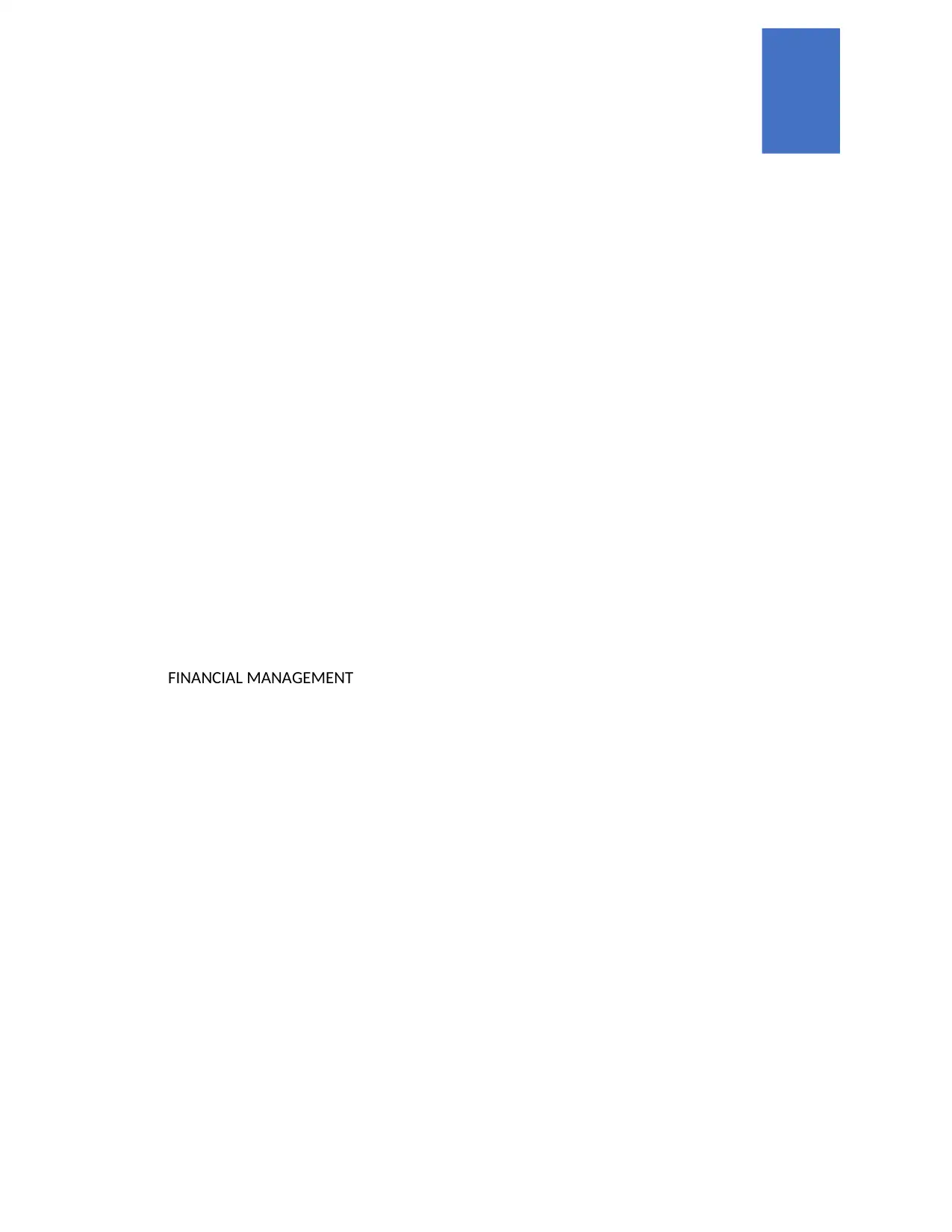
FINANCIAL MANAGEMENT
Paraphrase This Document
Need a fresh take? Get an instant paraphrase of this document with our AI Paraphraser
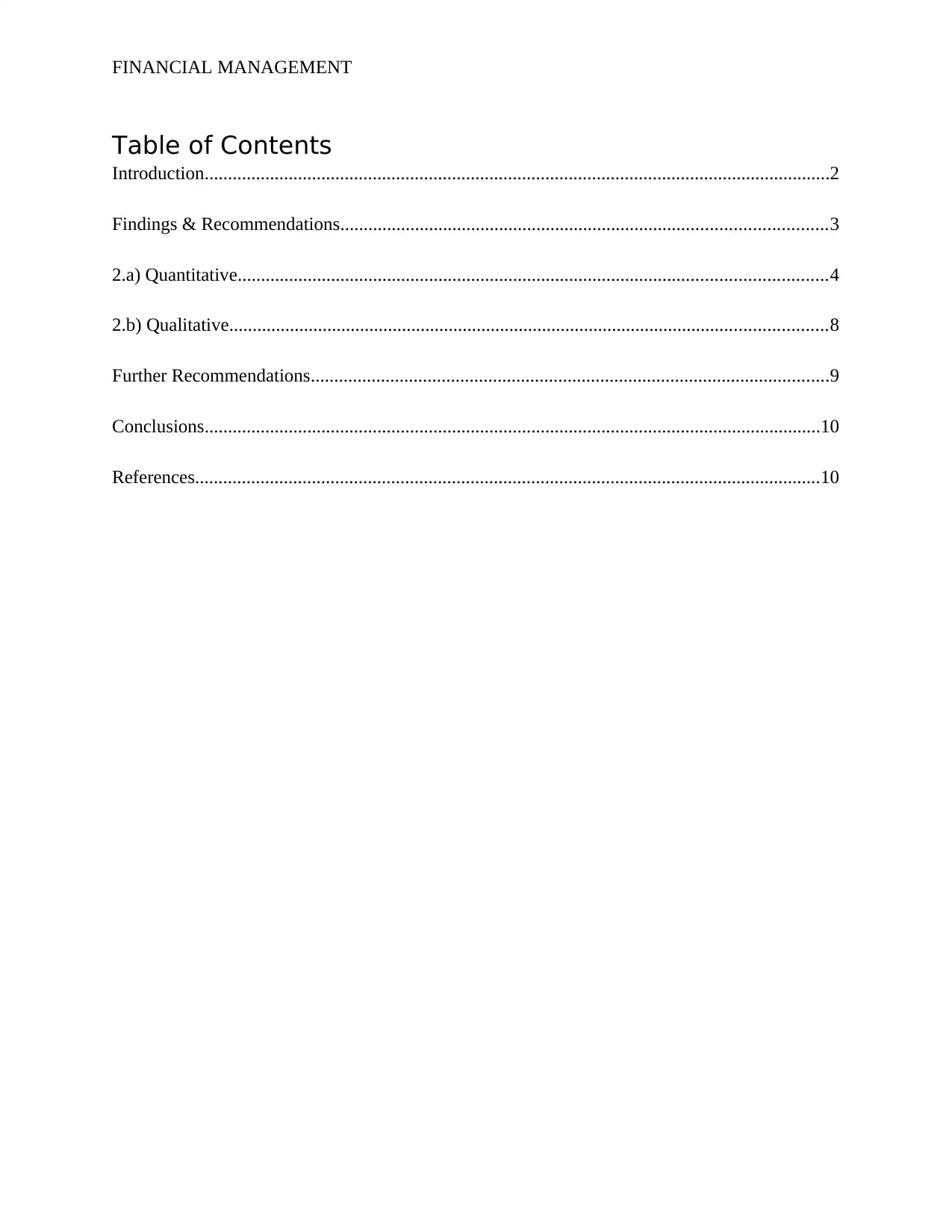
FINANCIAL MANAGEMENT
Table of Contents
Introduction......................................................................................................................................2
Findings & Recommendations........................................................................................................3
2.a) Quantitative..............................................................................................................................4
2.b) Qualitative................................................................................................................................8
Further Recommendations...............................................................................................................9
Conclusions....................................................................................................................................10
References......................................................................................................................................10
Table of Contents
Introduction......................................................................................................................................2
Findings & Recommendations........................................................................................................3
2.a) Quantitative..............................................................................................................................4
2.b) Qualitative................................................................................................................................8
Further Recommendations...............................................................................................................9
Conclusions....................................................................................................................................10
References......................................................................................................................................10
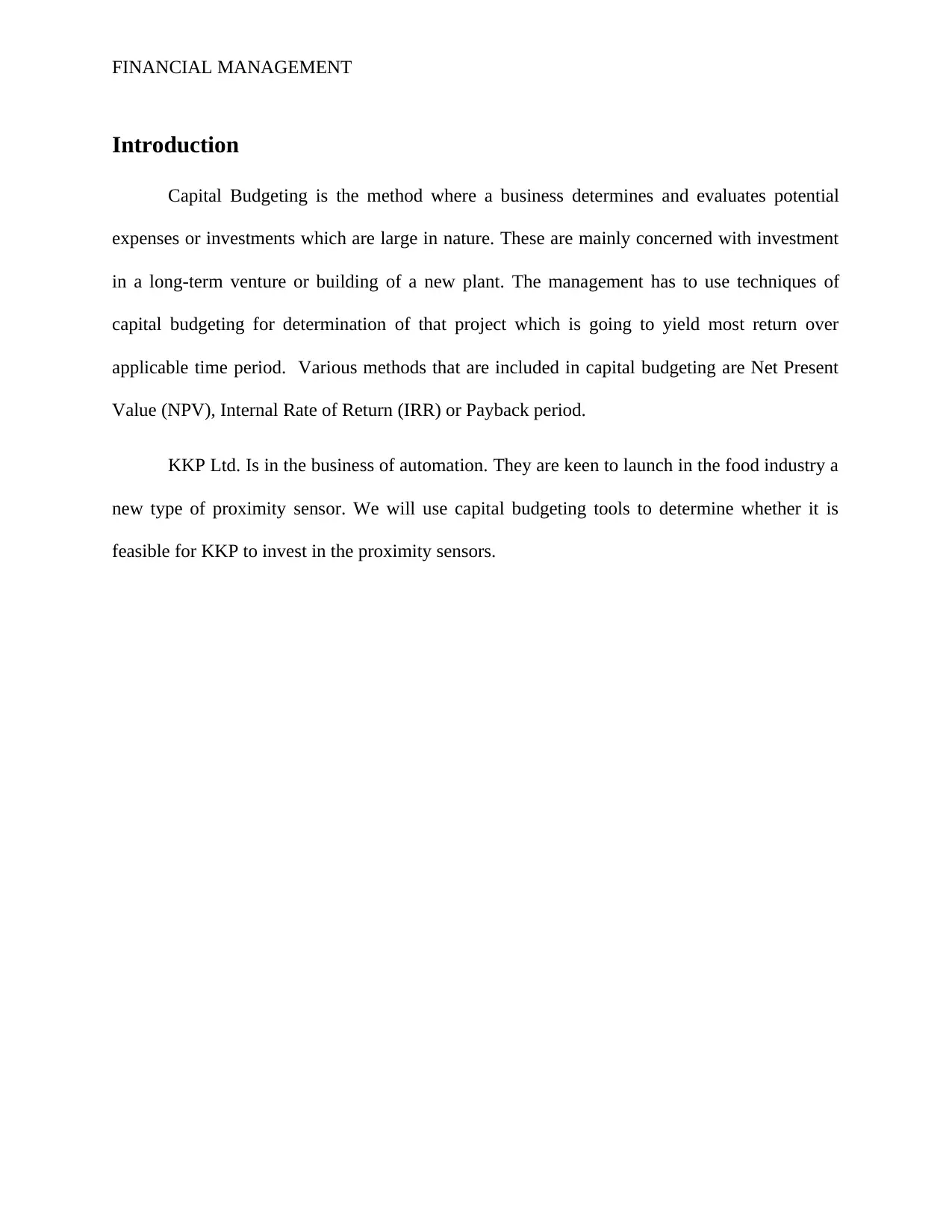
FINANCIAL MANAGEMENT
Introduction
Capital Budgeting is the method where a business determines and evaluates potential
expenses or investments which are large in nature. These are mainly concerned with investment
in a long-term venture or building of a new plant. The management has to use techniques of
capital budgeting for determination of that project which is going to yield most return over
applicable time period. Various methods that are included in capital budgeting are Net Present
Value (NPV), Internal Rate of Return (IRR) or Payback period.
KKP Ltd. Is in the business of automation. They are keen to launch in the food industry a
new type of proximity sensor. We will use capital budgeting tools to determine whether it is
feasible for KKP to invest in the proximity sensors.
Introduction
Capital Budgeting is the method where a business determines and evaluates potential
expenses or investments which are large in nature. These are mainly concerned with investment
in a long-term venture or building of a new plant. The management has to use techniques of
capital budgeting for determination of that project which is going to yield most return over
applicable time period. Various methods that are included in capital budgeting are Net Present
Value (NPV), Internal Rate of Return (IRR) or Payback period.
KKP Ltd. Is in the business of automation. They are keen to launch in the food industry a
new type of proximity sensor. We will use capital budgeting tools to determine whether it is
feasible for KKP to invest in the proximity sensors.
⊘ This is a preview!⊘
Do you want full access?
Subscribe today to unlock all pages.

Trusted by 1+ million students worldwide
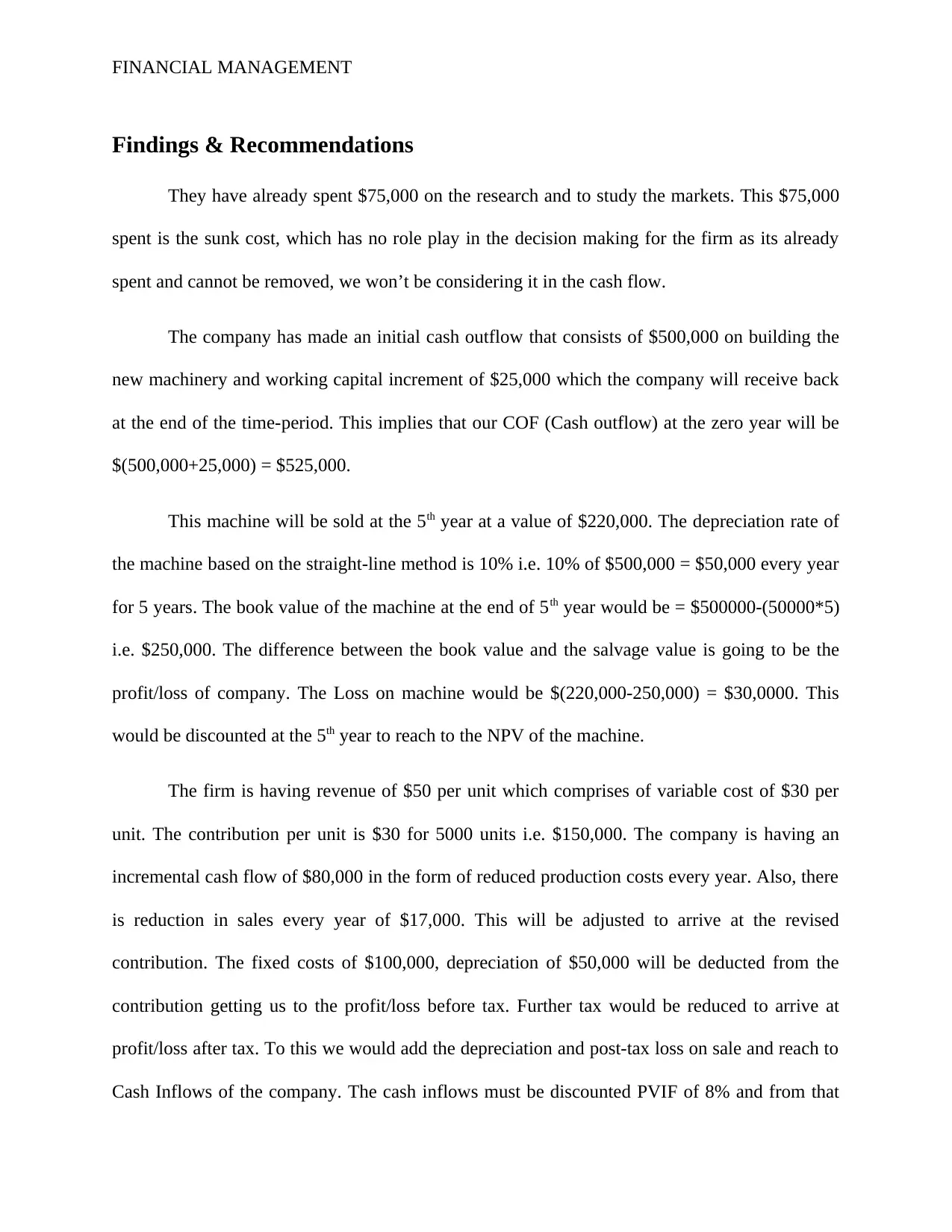
FINANCIAL MANAGEMENT
Findings & Recommendations
They have already spent $75,000 on the research and to study the markets. This $75,000
spent is the sunk cost, which has no role play in the decision making for the firm as its already
spent and cannot be removed, we won’t be considering it in the cash flow.
The company has made an initial cash outflow that consists of $500,000 on building the
new machinery and working capital increment of $25,000 which the company will receive back
at the end of the time-period. This implies that our COF (Cash outflow) at the zero year will be
$(500,000+25,000) = $525,000.
This machine will be sold at the 5th year at a value of $220,000. The depreciation rate of
the machine based on the straight-line method is 10% i.e. 10% of $500,000 = $50,000 every year
for 5 years. The book value of the machine at the end of 5th year would be = $500000-(50000*5)
i.e. $250,000. The difference between the book value and the salvage value is going to be the
profit/loss of company. The Loss on machine would be $(220,000-250,000) = $30,0000. This
would be discounted at the 5th year to reach to the NPV of the machine.
The firm is having revenue of $50 per unit which comprises of variable cost of $30 per
unit. The contribution per unit is $30 for 5000 units i.e. $150,000. The company is having an
incremental cash flow of $80,000 in the form of reduced production costs every year. Also, there
is reduction in sales every year of $17,000. This will be adjusted to arrive at the revised
contribution. The fixed costs of $100,000, depreciation of $50,000 will be deducted from the
contribution getting us to the profit/loss before tax. Further tax would be reduced to arrive at
profit/loss after tax. To this we would add the depreciation and post-tax loss on sale and reach to
Cash Inflows of the company. The cash inflows must be discounted PVIF of 8% and from that
Findings & Recommendations
They have already spent $75,000 on the research and to study the markets. This $75,000
spent is the sunk cost, which has no role play in the decision making for the firm as its already
spent and cannot be removed, we won’t be considering it in the cash flow.
The company has made an initial cash outflow that consists of $500,000 on building the
new machinery and working capital increment of $25,000 which the company will receive back
at the end of the time-period. This implies that our COF (Cash outflow) at the zero year will be
$(500,000+25,000) = $525,000.
This machine will be sold at the 5th year at a value of $220,000. The depreciation rate of
the machine based on the straight-line method is 10% i.e. 10% of $500,000 = $50,000 every year
for 5 years. The book value of the machine at the end of 5th year would be = $500000-(50000*5)
i.e. $250,000. The difference between the book value and the salvage value is going to be the
profit/loss of company. The Loss on machine would be $(220,000-250,000) = $30,0000. This
would be discounted at the 5th year to reach to the NPV of the machine.
The firm is having revenue of $50 per unit which comprises of variable cost of $30 per
unit. The contribution per unit is $30 for 5000 units i.e. $150,000. The company is having an
incremental cash flow of $80,000 in the form of reduced production costs every year. Also, there
is reduction in sales every year of $17,000. This will be adjusted to arrive at the revised
contribution. The fixed costs of $100,000, depreciation of $50,000 will be deducted from the
contribution getting us to the profit/loss before tax. Further tax would be reduced to arrive at
profit/loss after tax. To this we would add the depreciation and post-tax loss on sale and reach to
Cash Inflows of the company. The cash inflows must be discounted PVIF of 8% and from that
Paraphrase This Document
Need a fresh take? Get an instant paraphrase of this document with our AI Paraphraser
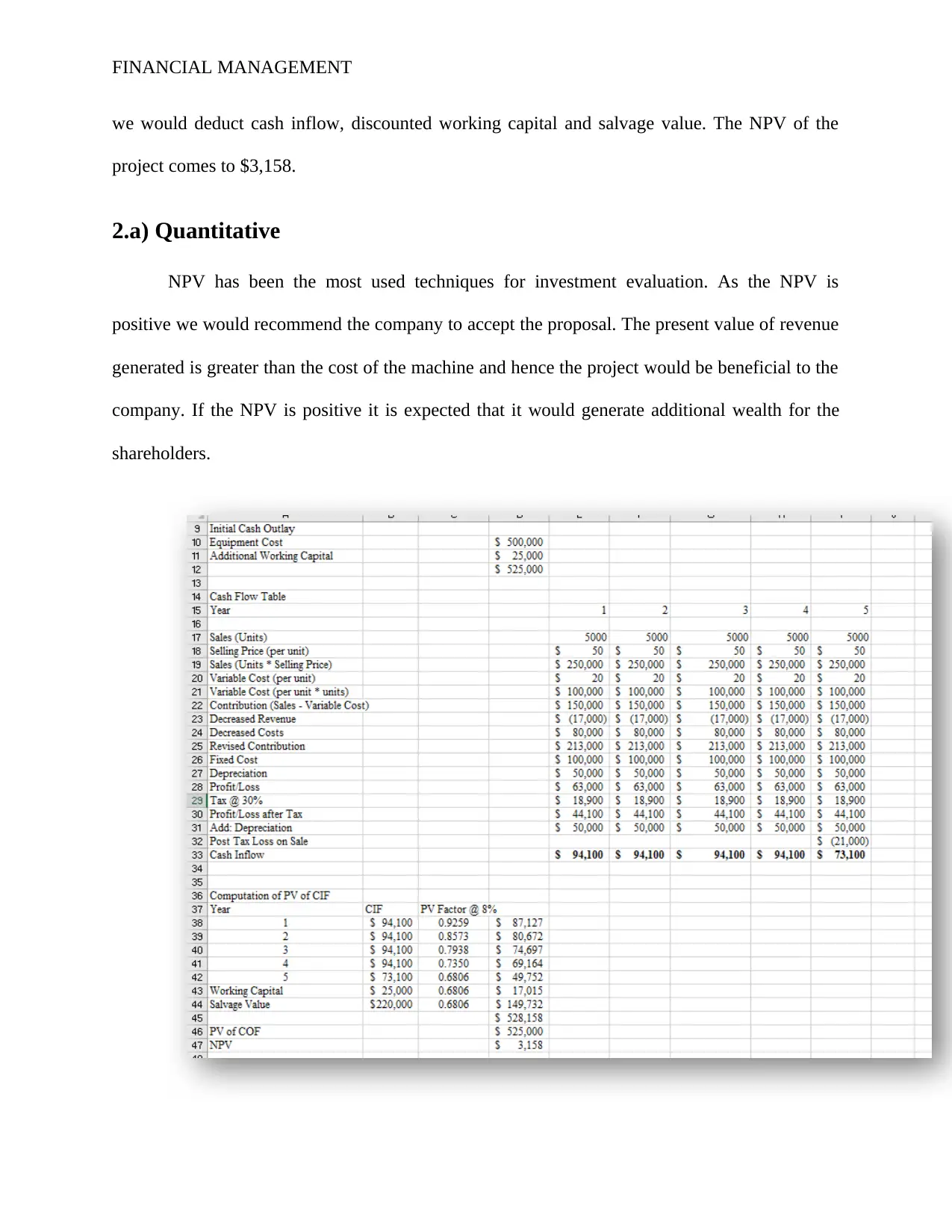
FINANCIAL MANAGEMENT
we would deduct cash inflow, discounted working capital and salvage value. The NPV of the
project comes to $3,158.
2.a) Quantitative
NPV has been the most used techniques for investment evaluation. As the NPV is
positive we would recommend the company to accept the proposal. The present value of revenue
generated is greater than the cost of the machine and hence the project would be beneficial to the
company. If the NPV is positive it is expected that it would generate additional wealth for the
shareholders.
we would deduct cash inflow, discounted working capital and salvage value. The NPV of the
project comes to $3,158.
2.a) Quantitative
NPV has been the most used techniques for investment evaluation. As the NPV is
positive we would recommend the company to accept the proposal. The present value of revenue
generated is greater than the cost of the machine and hence the project would be beneficial to the
company. If the NPV is positive it is expected that it would generate additional wealth for the
shareholders.

FINANCIAL MANAGEMENT
⊘ This is a preview!⊘
Do you want full access?
Subscribe today to unlock all pages.

Trusted by 1+ million students worldwide
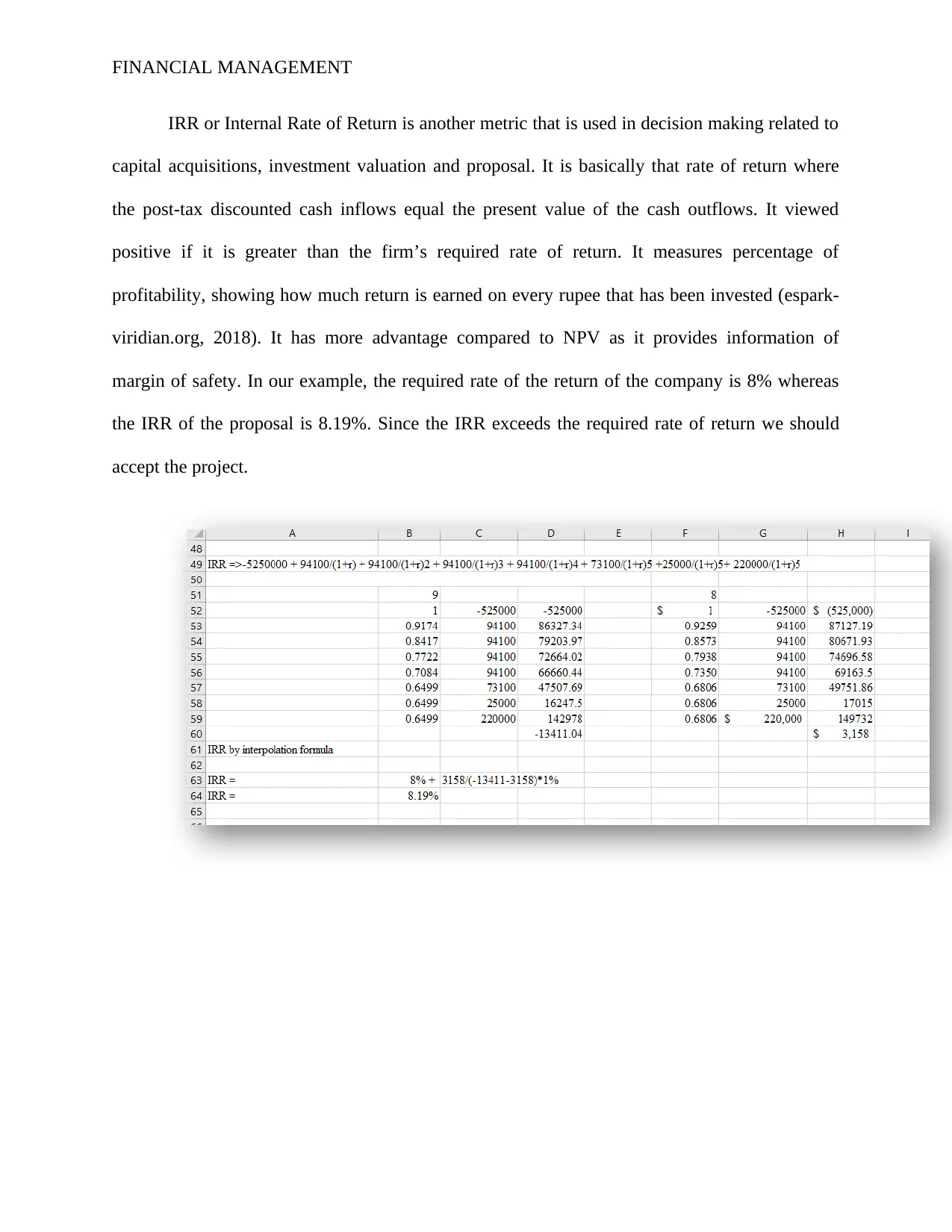
FINANCIAL MANAGEMENT
IRR or Internal Rate of Return is another metric that is used in decision making related to
capital acquisitions, investment valuation and proposal. It is basically that rate of return where
the post-tax discounted cash inflows equal the present value of the cash outflows. It viewed
positive if it is greater than the firm’s required rate of return. It measures percentage of
profitability, showing how much return is earned on every rupee that has been invested (espark-
viridian.org, 2018). It has more advantage compared to NPV as it provides information of
margin of safety. In our example, the required rate of the return of the company is 8% whereas
the IRR of the proposal is 8.19%. Since the IRR exceeds the required rate of return we should
accept the project.
IRR or Internal Rate of Return is another metric that is used in decision making related to
capital acquisitions, investment valuation and proposal. It is basically that rate of return where
the post-tax discounted cash inflows equal the present value of the cash outflows. It viewed
positive if it is greater than the firm’s required rate of return. It measures percentage of
profitability, showing how much return is earned on every rupee that has been invested (espark-
viridian.org, 2018). It has more advantage compared to NPV as it provides information of
margin of safety. In our example, the required rate of the return of the company is 8% whereas
the IRR of the proposal is 8.19%. Since the IRR exceeds the required rate of return we should
accept the project.
Paraphrase This Document
Need a fresh take? Get an instant paraphrase of this document with our AI Paraphraser
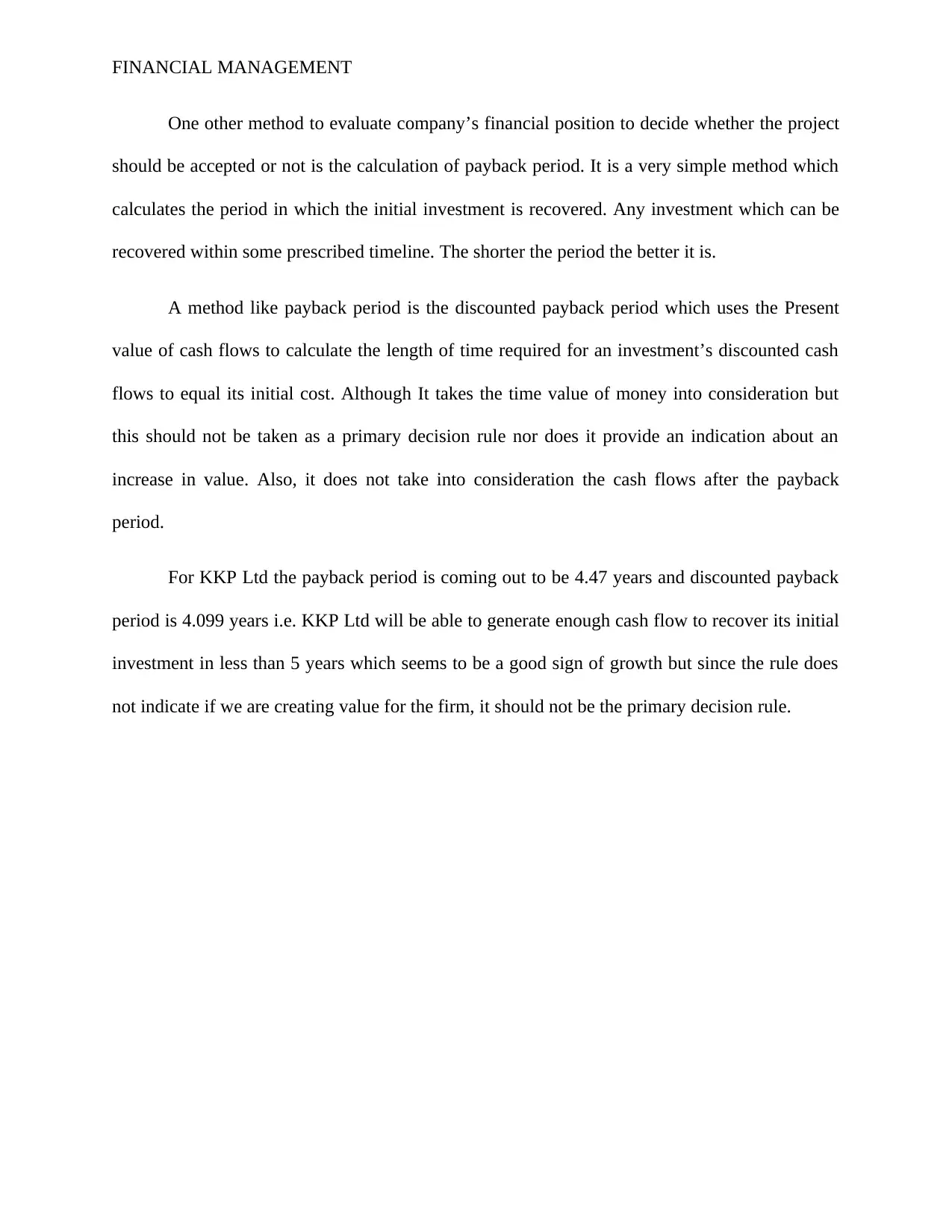
FINANCIAL MANAGEMENT
One other method to evaluate company’s financial position to decide whether the project
should be accepted or not is the calculation of payback period. It is a very simple method which
calculates the period in which the initial investment is recovered. Any investment which can be
recovered within some prescribed timeline. The shorter the period the better it is.
A method like payback period is the discounted payback period which uses the Present
value of cash flows to calculate the length of time required for an investment’s discounted cash
flows to equal its initial cost. Although It takes the time value of money into consideration but
this should not be taken as a primary decision rule nor does it provide an indication about an
increase in value. Also, it does not take into consideration the cash flows after the payback
period.
For KKP Ltd the payback period is coming out to be 4.47 years and discounted payback
period is 4.099 years i.e. KKP Ltd will be able to generate enough cash flow to recover its initial
investment in less than 5 years which seems to be a good sign of growth but since the rule does
not indicate if we are creating value for the firm, it should not be the primary decision rule.
One other method to evaluate company’s financial position to decide whether the project
should be accepted or not is the calculation of payback period. It is a very simple method which
calculates the period in which the initial investment is recovered. Any investment which can be
recovered within some prescribed timeline. The shorter the period the better it is.
A method like payback period is the discounted payback period which uses the Present
value of cash flows to calculate the length of time required for an investment’s discounted cash
flows to equal its initial cost. Although It takes the time value of money into consideration but
this should not be taken as a primary decision rule nor does it provide an indication about an
increase in value. Also, it does not take into consideration the cash flows after the payback
period.
For KKP Ltd the payback period is coming out to be 4.47 years and discounted payback
period is 4.099 years i.e. KKP Ltd will be able to generate enough cash flow to recover its initial
investment in less than 5 years which seems to be a good sign of growth but since the rule does
not indicate if we are creating value for the firm, it should not be the primary decision rule.
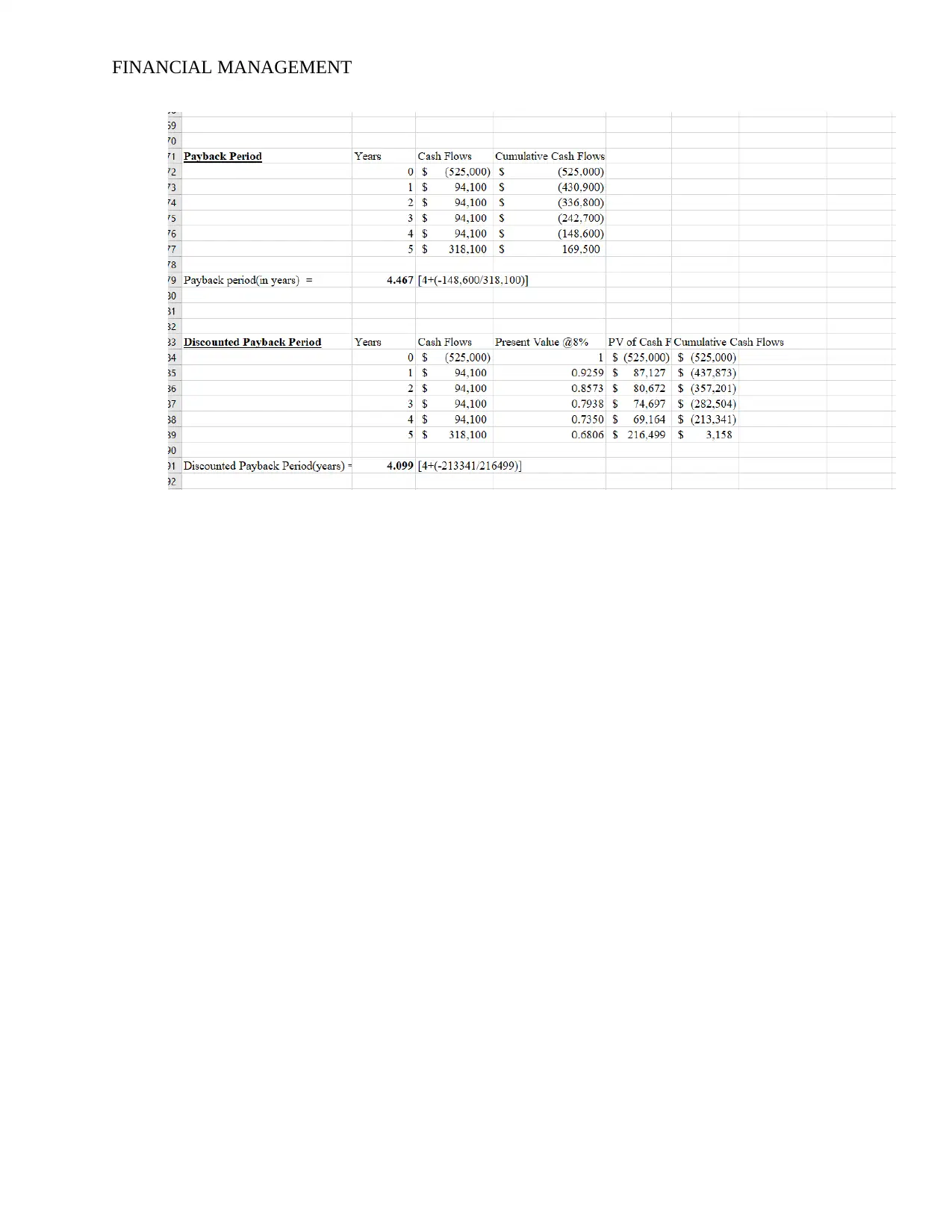
FINANCIAL MANAGEMENT
⊘ This is a preview!⊘
Do you want full access?
Subscribe today to unlock all pages.

Trusted by 1+ million students worldwide
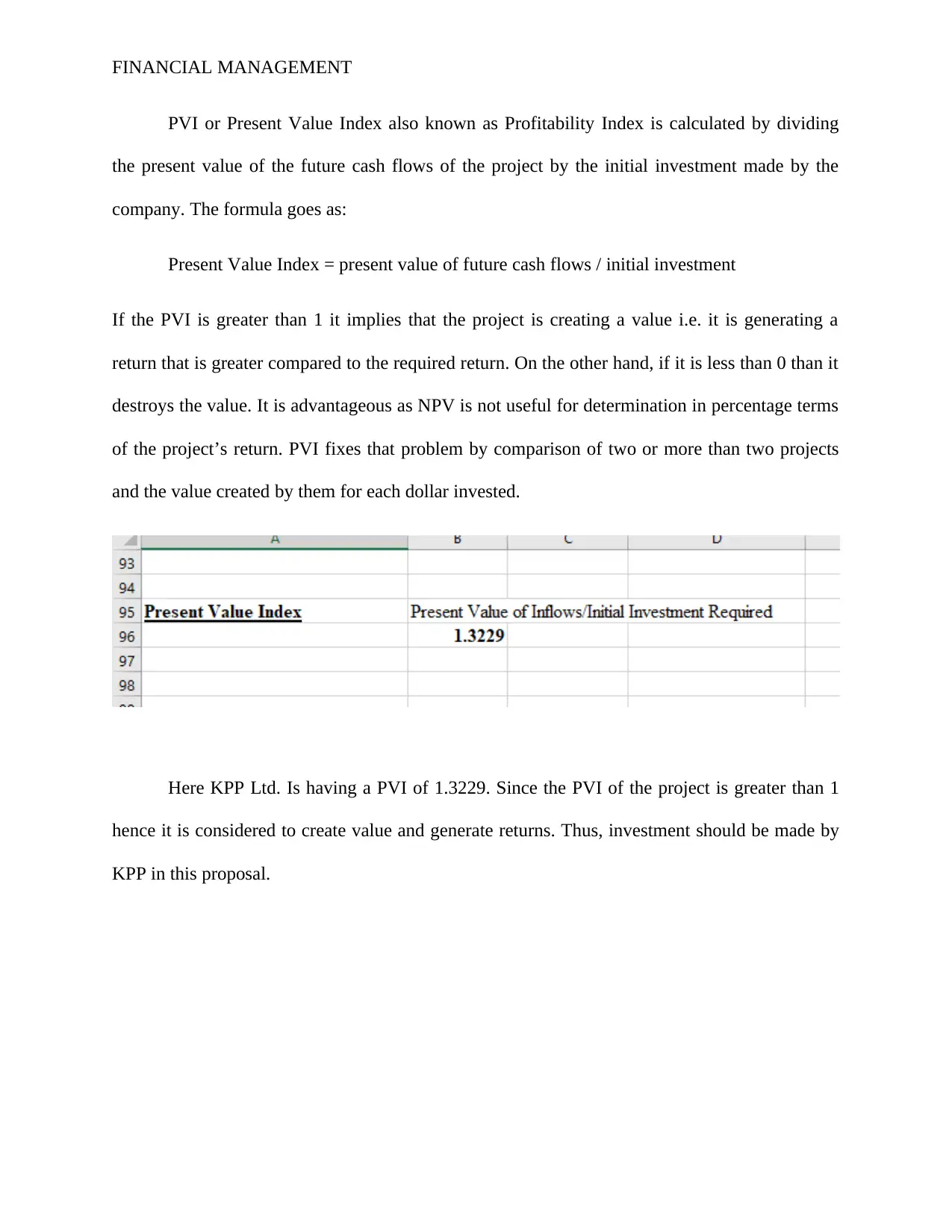
FINANCIAL MANAGEMENT
PVI or Present Value Index also known as Profitability Index is calculated by dividing
the present value of the future cash flows of the project by the initial investment made by the
company. The formula goes as:
Present Value Index = present value of future cash flows / initial investment
If the PVI is greater than 1 it implies that the project is creating a value i.e. it is generating a
return that is greater compared to the required return. On the other hand, if it is less than 0 than it
destroys the value. It is advantageous as NPV is not useful for determination in percentage terms
of the project’s return. PVI fixes that problem by comparison of two or more than two projects
and the value created by them for each dollar invested.
Here KPP Ltd. Is having a PVI of 1.3229. Since the PVI of the project is greater than 1
hence it is considered to create value and generate returns. Thus, investment should be made by
KPP in this proposal.
PVI or Present Value Index also known as Profitability Index is calculated by dividing
the present value of the future cash flows of the project by the initial investment made by the
company. The formula goes as:
Present Value Index = present value of future cash flows / initial investment
If the PVI is greater than 1 it implies that the project is creating a value i.e. it is generating a
return that is greater compared to the required return. On the other hand, if it is less than 0 than it
destroys the value. It is advantageous as NPV is not useful for determination in percentage terms
of the project’s return. PVI fixes that problem by comparison of two or more than two projects
and the value created by them for each dollar invested.
Here KPP Ltd. Is having a PVI of 1.3229. Since the PVI of the project is greater than 1
hence it is considered to create value and generate returns. Thus, investment should be made by
KPP in this proposal.
Paraphrase This Document
Need a fresh take? Get an instant paraphrase of this document with our AI Paraphraser
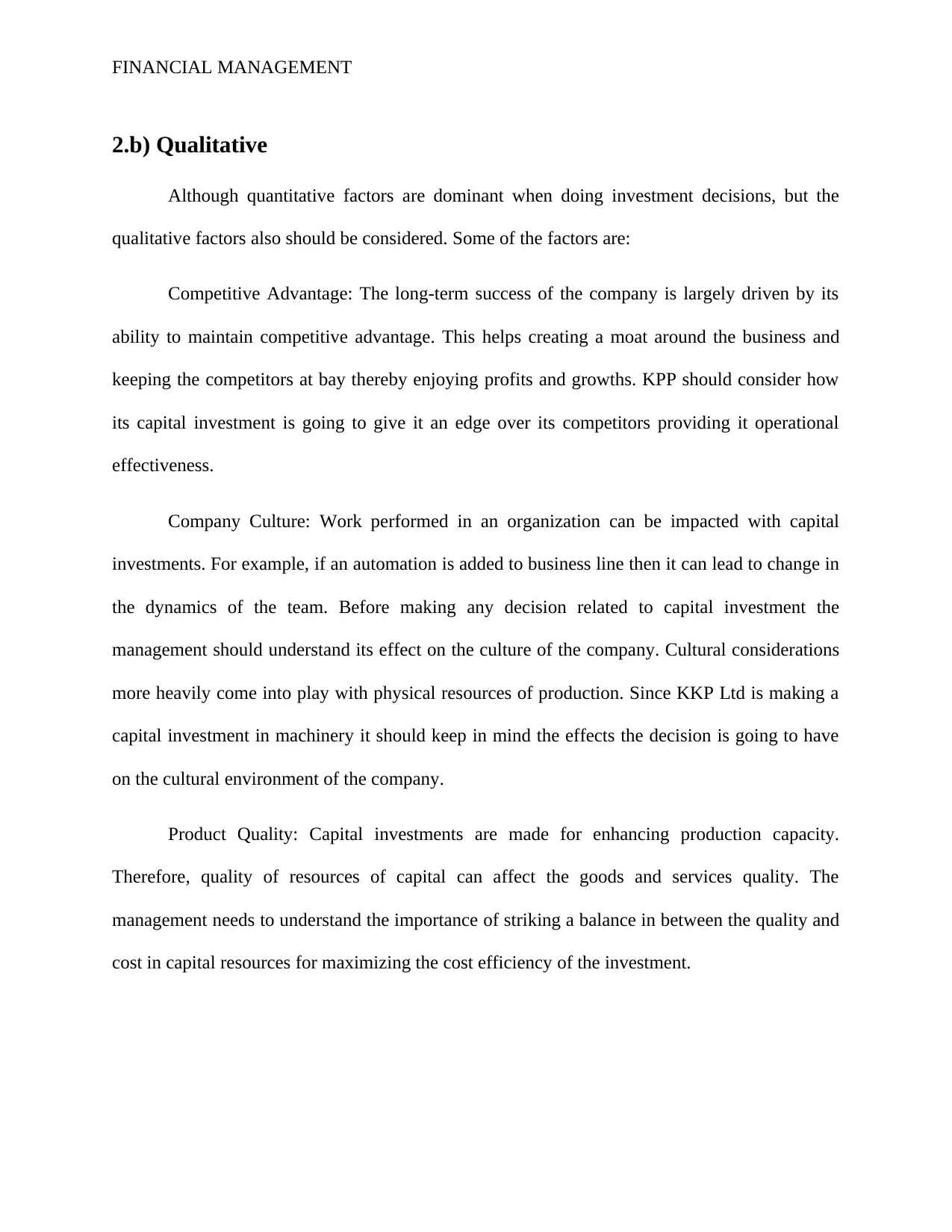
FINANCIAL MANAGEMENT
2.b) Qualitative
Although quantitative factors are dominant when doing investment decisions, but the
qualitative factors also should be considered. Some of the factors are:
Competitive Advantage: The long-term success of the company is largely driven by its
ability to maintain competitive advantage. This helps creating a moat around the business and
keeping the competitors at bay thereby enjoying profits and growths. KPP should consider how
its capital investment is going to give it an edge over its competitors providing it operational
effectiveness.
Company Culture: Work performed in an organization can be impacted with capital
investments. For example, if an automation is added to business line then it can lead to change in
the dynamics of the team. Before making any decision related to capital investment the
management should understand its effect on the culture of the company. Cultural considerations
more heavily come into play with physical resources of production. Since KKP Ltd is making a
capital investment in machinery it should keep in mind the effects the decision is going to have
on the cultural environment of the company.
Product Quality: Capital investments are made for enhancing production capacity.
Therefore, quality of resources of capital can affect the goods and services quality. The
management needs to understand the importance of striking a balance in between the quality and
cost in capital resources for maximizing the cost efficiency of the investment.
2.b) Qualitative
Although quantitative factors are dominant when doing investment decisions, but the
qualitative factors also should be considered. Some of the factors are:
Competitive Advantage: The long-term success of the company is largely driven by its
ability to maintain competitive advantage. This helps creating a moat around the business and
keeping the competitors at bay thereby enjoying profits and growths. KPP should consider how
its capital investment is going to give it an edge over its competitors providing it operational
effectiveness.
Company Culture: Work performed in an organization can be impacted with capital
investments. For example, if an automation is added to business line then it can lead to change in
the dynamics of the team. Before making any decision related to capital investment the
management should understand its effect on the culture of the company. Cultural considerations
more heavily come into play with physical resources of production. Since KKP Ltd is making a
capital investment in machinery it should keep in mind the effects the decision is going to have
on the cultural environment of the company.
Product Quality: Capital investments are made for enhancing production capacity.
Therefore, quality of resources of capital can affect the goods and services quality. The
management needs to understand the importance of striking a balance in between the quality and
cost in capital resources for maximizing the cost efficiency of the investment.
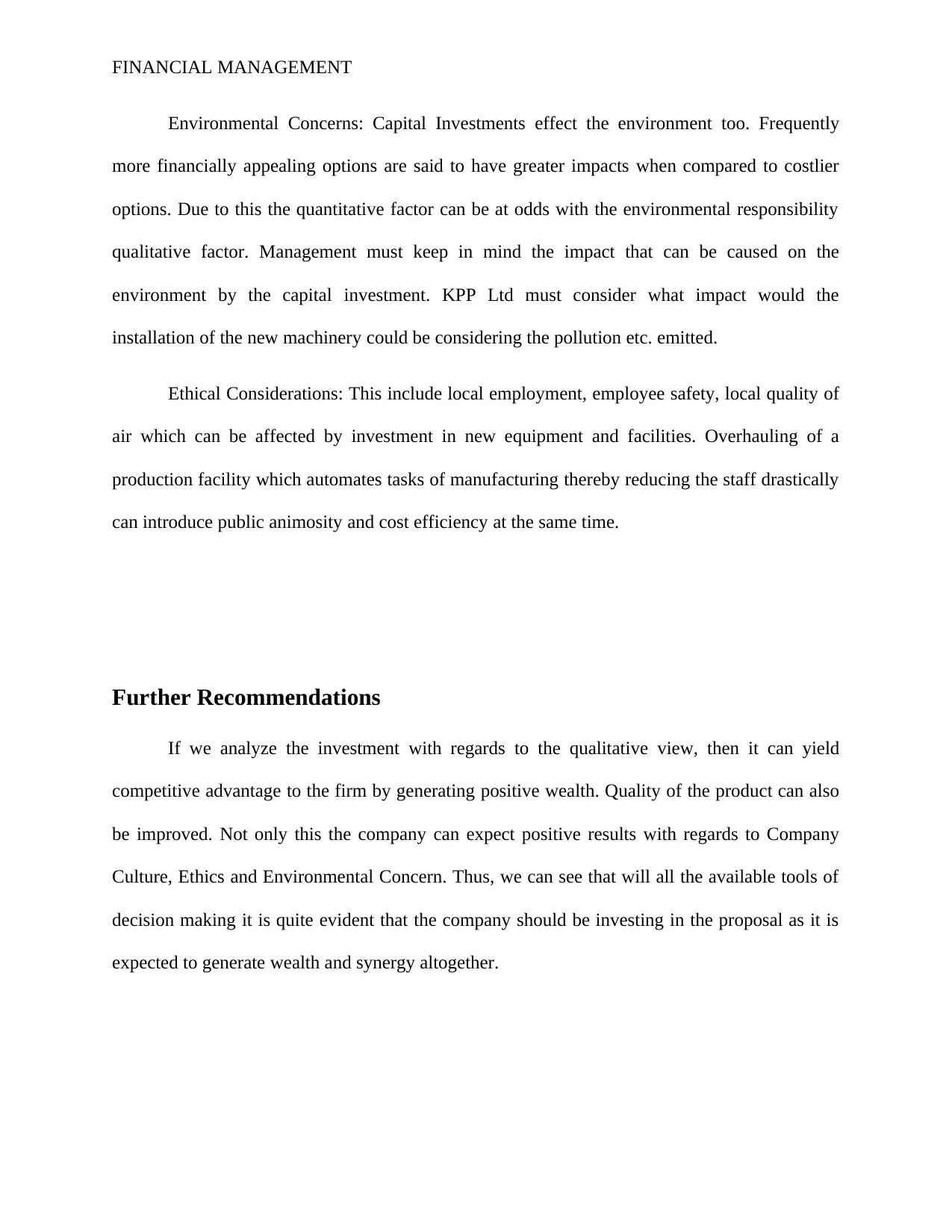
FINANCIAL MANAGEMENT
Environmental Concerns: Capital Investments effect the environment too. Frequently
more financially appealing options are said to have greater impacts when compared to costlier
options. Due to this the quantitative factor can be at odds with the environmental responsibility
qualitative factor. Management must keep in mind the impact that can be caused on the
environment by the capital investment. KPP Ltd must consider what impact would the
installation of the new machinery could be considering the pollution etc. emitted.
Ethical Considerations: This include local employment, employee safety, local quality of
air which can be affected by investment in new equipment and facilities. Overhauling of a
production facility which automates tasks of manufacturing thereby reducing the staff drastically
can introduce public animosity and cost efficiency at the same time.
Further Recommendations
If we analyze the investment with regards to the qualitative view, then it can yield
competitive advantage to the firm by generating positive wealth. Quality of the product can also
be improved. Not only this the company can expect positive results with regards to Company
Culture, Ethics and Environmental Concern. Thus, we can see that will all the available tools of
decision making it is quite evident that the company should be investing in the proposal as it is
expected to generate wealth and synergy altogether.
Environmental Concerns: Capital Investments effect the environment too. Frequently
more financially appealing options are said to have greater impacts when compared to costlier
options. Due to this the quantitative factor can be at odds with the environmental responsibility
qualitative factor. Management must keep in mind the impact that can be caused on the
environment by the capital investment. KPP Ltd must consider what impact would the
installation of the new machinery could be considering the pollution etc. emitted.
Ethical Considerations: This include local employment, employee safety, local quality of
air which can be affected by investment in new equipment and facilities. Overhauling of a
production facility which automates tasks of manufacturing thereby reducing the staff drastically
can introduce public animosity and cost efficiency at the same time.
Further Recommendations
If we analyze the investment with regards to the qualitative view, then it can yield
competitive advantage to the firm by generating positive wealth. Quality of the product can also
be improved. Not only this the company can expect positive results with regards to Company
Culture, Ethics and Environmental Concern. Thus, we can see that will all the available tools of
decision making it is quite evident that the company should be investing in the proposal as it is
expected to generate wealth and synergy altogether.
⊘ This is a preview!⊘
Do you want full access?
Subscribe today to unlock all pages.

Trusted by 1+ million students worldwide
1 out of 13
Related Documents
Your All-in-One AI-Powered Toolkit for Academic Success.
+13062052269
info@desklib.com
Available 24*7 on WhatsApp / Email
![[object Object]](/_next/static/media/star-bottom.7253800d.svg)
Unlock your academic potential
Copyright © 2020–2025 A2Z Services. All Rights Reserved. Developed and managed by ZUCOL.





